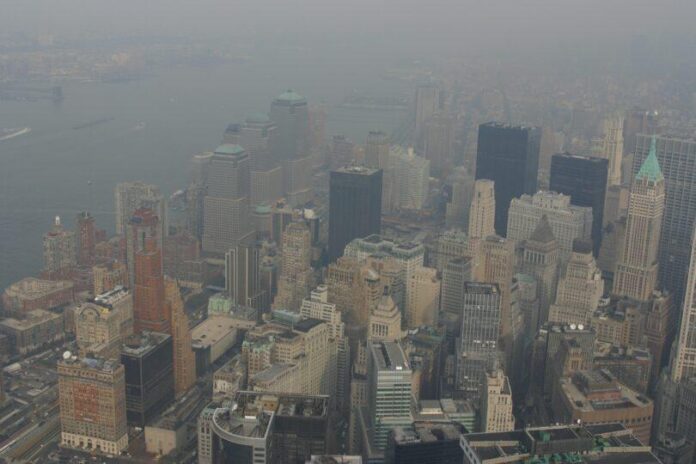Despite comprising 41.6% of the U.S. population, people of color represent 52% of those living in counties with at least one failing grade for air quality.
The American Lung Association’s 25th annual “State of the Air” report has revealed significant disparities in air quality across the United States, with people of color, low-income communities, children, older adults, and individuals with underlying health conditions disproportionately affected.
Despite comprising 41.6% of the U.S. population, people of color represent 52% of those living in counties with at least one failing grade for air quality. In counties with the poorest air quality, where failing grades are given for all three measures of air pollution, 63% of the nearly 44 million residents are people of color, compared to 37% white.
Bakersfield, Calif.; Fresno-Madera-Hanford (Calif.); Fairbanks, AK; Eugene-Springfield, Oregon; and Visalia, Calif., counted as the top five cities most polluted by short-term particle pollution. Meanwhile, the California cities of San Jose, San Francisco, and Oakland, joined the others as the most heavily polluted by year-round particle pollution. The report’s authors also noted that ground-level ozone pollution is a powerful respiratory irritant whose effects have been likened to a sunburn of the lungs. Inhaling ozone can cause shortness of breath, trigger coughing and asthma attacks and may shorten life. They said warmer temperatures driven by climate change make ozone more likely to form and harder to clean up. The top five cities most affected by ozone pollution are the Los Angeles-Long Beach area, Visalia, Bakersfield, the Fresno-Madera-Hanford area, and the Phoenix-Mesa, Arizona area.
The report also recognized the nation’s cleanest cities. To make the cleanest list for all three measures, a city must experience no high ozone or particle pollution days and rank among the 25 cities with the lowest year-round particle pollution levels. The top five were Bangor, Maine; the Johnson City-Kingsport-Briston, Tennessee and Virginia area; Lincoln-Beatrice, Nebraska area; Urban Honolulu, Hawaii; and Wilmington, North Carolina.
The report highlighted that approximately 68.9 million people of color live in counties that received at least one failing grade for ozone and/or particle pollution. Over 27.5 million people of color reside in counties with failing grades on all three measures, including about 16.8 million Hispanics. Additionally, 16 million people living in poverty are in counties that received a failing grade for at least one pollutant, with more than 5.4 million in counties failing all three measures.
Further, the report revealed that more than 29.2 million children under 18 and 20.6 million adults aged 65 and over live in counties with at least one failing grade for pollution. More than 9.7 million children and 6.7 million seniors reside in counties failing all three measures.
The impact of air pollution on vulnerable populations is significant. Over 1.9 million children and nearly 9.8 million adults with asthma live in counties with at least one failing grade for pollution. In comparison, more than 600,000 children and 3.1 million adults with asthma reside in counties failing all three measures. Additionally, about 6.0 million people with Chronic Obstructive Pulmonary Disease (COPD) live in counties with at least one failing grade for pollution, including over 1.7 million in counties failing all three measures.
“We have seen impressive progress in cleaning up air pollution over the last 25 years, thanks in large part to the Clean Air Act. However, when we started this report, our team never imagined that 25 years in the future, more than 130 million people would still be breathing unhealthy air,” said Harold Wimmer, president, and CEO of the American Lung Association.
The report also underscored the association between exposure to air pollution and increased risks of severe illness and death from COVID-19. A 2022 study in California found that residents in the most polluted areas had a 20% higher risk of COVID-19 infection and a 51% higher risk of death than those in the least polluted areas.
The authors noted that these disparities in air quality exposure can be traced back to systemic racism in the U.S., including practices like redlining and institutionalized residential segregation. Historically, decision-makers have placed pollution sources, such as power plants and industrial facilities, in poor communities of color, contributing to high rates of emergency department visits for asthma and other diseases.
People of color are also more likely to live with chronic conditions like asthma and diabetes, making them more susceptible to the health impacts of air pollution. Addressing these disparities requires comprehensive efforts to improve air quality, promote environmental justice, and protect the health of vulnerable communities, the authors concluded.
“Climate change is causing more dangerous air pollution,” Wimmer added. “Every day that there are unhealthy levels of ozone or particle pollution means that someone – a child, grandparent, uncle, or mother – struggles to breathe. We must do more to ensure everyone has clean air.”
Air pollution air quality American Lung Association failing grade People of Color




